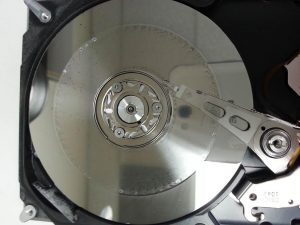Hard drive platter contamination occurs when foreign particles (or contaminants) reach the platters that store your data. The platters are thin metal or plastic discs covered with a thin magnetic material.
Under normal conditions, read/write heads float just above the surface of the platters to access the magnetic charges in each sector. Platter contamination is a problem for several reasons:
- Contaminants can come between the read/write heads and the platters, impeding the drive’s ability to read any data.
- A single contaminant may also cause the read/write heads to “skip” by disturbing the thin cushion of air created by rotation. This can lead to a read/write head crash (during which the heads come into direct contact with the platters).
- Contaminants directly on the platters may prevent certain sectors from being accessed.
- Contaminants “stuck” on the read/write heads could cause rotational scoring (physical damage to the platters that occurs as the contaminant is dragged across the surface of the discs).
If the platters are permanently damaged, some data will be permanently lost. Severe rotational damage can destroy all data on a hard drive, and with sufficient contamination, this damage can occur within a few seconds as the drive attempts to operate.
Here’s a photograph of a hard drive with severe rotational damage, which occurred due to direct contact between the read/write heads and platters.

Rotational damage to hard drive platters.
The solution is to perform all physical data recovery procedures within a certified cleanroom. This is particularly important for newer drives that use SMR/HAMR (Shingled Magnetic Recording / Heat Assisted Magnetic Recording) technologies, both of which allow for high areal densities (areal density refers to the amount of data stored in a given amount of space on the drive platters).
Related: Data Recovery Clean Room Technology
What causes hard drive platter contamination?
Opening a hard drive in an uncontrolled environment can (and will) cause platter contamination. In short, if you don’t have a certified cleanroom, you should not attempt to repair a drive that shows physical signs of damage — even if the repair seems fairly simple.
Common signs of physical hard drive damage include:
- Clicking, whirring, grinding, or tapping sounds.
- Widespread file corruption.
- Missing files.
- The operating system fails to recognize the drive.
- The operating system identifies the drive, but reports the wrong model name or capacity.
This is not an exhaustive list, and in some cases, hard drives may appear to operate normally after suffering a severe failure. For that reason, reputable data recovery providers offer risk-free evaluations to determine the cause (and extent) of hard drive damage.
Related: How Can I Tell If My Hard Drive is Broken?
So, can platter contamination occur if you don’t open your hard drive in an uncontrolled environment?
Possibly, but not typically. While hard drive enclosures are not airtight, they have filters to prevent external contaminants from reaching the platters. Those filters aren’t perfect; if a hard drive operates in a room with heavy smoke or other airborne contaminants, some of those particles might make their way into the enclosure.
Of course, this is rare — usually, if your hard drive is contaminated, it’s usually not related to ambient operating conditions.
I’ve already opened my hard drive. What can I do to prevent platter contamination?
Put the hard drive’s cover back into place. Do not attempt to clean the platters or remove contaminants, and do not operate the hard drive.
In most cases, data is still recoverable, provided that you haven’t done much to the drive (such as changing the platter orientation, removing/replacing components, or attempting to clean components with chemicals).
However, you’ll usually have one chance to recover your data — if your files are truly important, you should work with an experienced data recovery provider to maximize your chances of a successful case result.
Datarecovery.com provides professional data recovery services for all hard drive brands, makes, models, and architectures. We provide a no data, no charge guarantee: If we’re unable to recover the files you need, you don’t pay for the attempt.
To learn more about our services, call 1-800-237-4200 or submit a case online.





